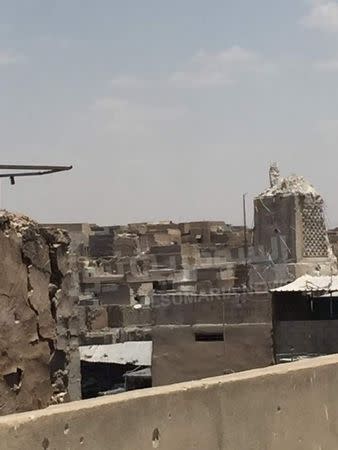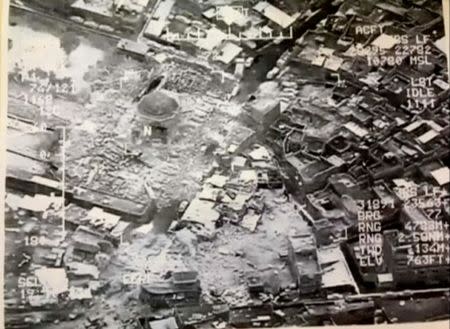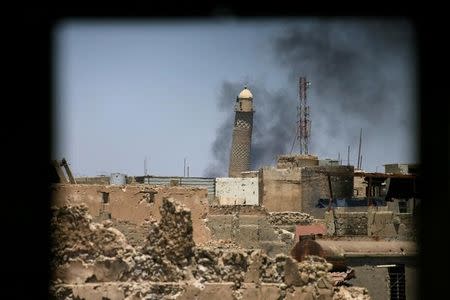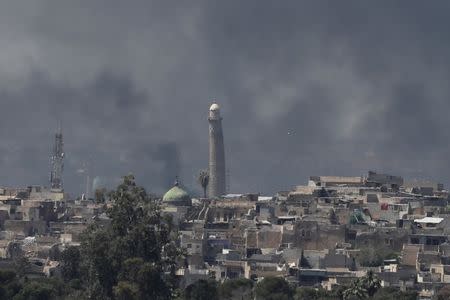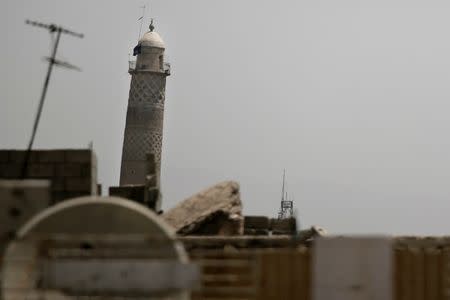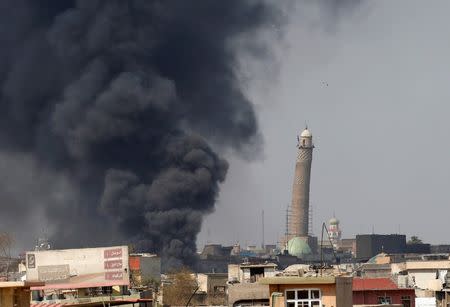Anger in Mosul as Islamic State destroys historic mosque
By Kawa Omar and Ahmed Rasheed MOSUL/BAGHDAD, Iraq (Reuters) - The leaning al-Hadba minaret that towered over Mosul for 850 years lay in ruins on Thursday, demolished by retreating Islamic State militants, but Iraq's prime minister said the act marked their final defeat in the city. "In the early morning, I climbed up to the roof of my house and was stunned to see the Hadba minaret had gone," Nashwan, a day-laborer who lives near the mosque, said by phone. "I felt I had lost a son of mine." His words echoed the shock and anger of many over the destruction of the Grand al-Nuri Mosque along with its famous minaret, known affectionately as "the hunchback" by Iraqis. The demolition came on Wednesday night as Iraqi forces closed in on the mosque, which carried enormous symbolic importance for Islamic State (IS). It was there that its leader Abu Bakr al-Baghdadi declared a "caliphate" as militants seized swathes of Syria and Iraq. He proclaimed himself the caliph, ruler of all Muslims, from the mosque's pulpit. His black flag had been flying on the 150-foot (45-metre) minaret since June 2014, after Islamic State fighters surged across Iraq. Russia said on Thursday there was a high degree of certainty Baghdadi was dead, according to RIA news agency. Moscow said last week its forces might have killed him, but Western and Iraqi officials are skeptical. Baghdadi has left the fighting in Mosul to local commanders and is believed to be hiding in the border area between Iraq and Syria. LIBERATION "IN DAYS" Some analysts said the destruction of the mosque could in fact speed the advance of government forces, which had been slowed by fear of damaging it. Iraqi Prime Minister Haider al-Abadi went further. "Blowing up the al-Hadba minaret and the al-Nuri mosque amounts to an official acknowledgement of defeat," he said on his website. "It's a matter of a few days and we will announce the total liberation of Mosul," he later told reporters in Baghdad, pledging to rebuild the mosque and other historical sites destroyed by the insurgents. The jihadists appear to have chosen to blow up the mosque rather than see their flag torn down by U.S.-backed Iraqi forces battling through the maze of narrow alleys and streets of the Old City, the last district of Mosul still under the control of Islamic State. In the dawn light, all that remained was the base projecting from shattered masonry. A video on social media showed the minaret collapsing vertically, throwing up a pall of sand and dust. Defense analysts said the decision to destroy the mosque could indicate the militants were on the verge of collapse. "They had said they would fight until their last breath defending the mosque," Baghdad-based security expert Safaa al-A’sam told Reuters. "The fact is that they are no longer capable of standing in the face of Iraqi government forces." The minaret had seven bands of decorative brickwork in a type of complex geometric pattern also found in Persia and Central Asia. Its tilt and the lack of maintenance made it particularly vulnerable to blasts. U.S. Army Colonel Ryan Dillon, spokesman for the U.S.-led international coalition assisting the Iraqi effort to defeat Islamic State, said Iraqi security forces were continuing to push into remaining IS-held territory. "There are two square kilometers left in West Mosul before the entire city is liberated," he told Reuters by phone. The fall of Mosul would mark the effective end of the Iraqi half of the "caliphate", though Islamic State would still hold some territory west and south of the city. U.S.-backed militias are also closing on Islamic State's Syrian stronghold, Raqqa. "SYMBOL OF IDENTITY" The United Nations' education organization UNESCO said the Mosul minaret and mosque "stood as a symbol of identity, resilience and belonging" and it deplored their destruction. The mosque was named after Nuruddin al-Zanki, a noble who fought the early crusaders from a fiefdom that covered territory in modern-day Turkey, Syria and Iraq. The mosque's military and religious history embodied the spirit of Mosul, a city which supplied Iraq's armed forces with officers for much of the 20th century. With the fall of Saddam Hussein in the 2003 U.S.-led invasion, the Sunni city balked at its loss of influence and some local people joined the insurgency against the new Shi'ite rulers of the country. When Islamic State swept into Mosul in June 2014, they were welcomed by those who saw the takeover as promising an end to harsh treatment by Shi'ite-led security forces. The mosque's destruction comes in the holiest period of the Islamic holy month of Ramadan, its final 10 days. The night of Laylat al-Qadr falls during this period, when Muslims believe the Koran was revealed to the prophet Mohammed. Islamic State fighters have destroyed many Muslim religious sites and Christian churches and shrines, as well as ancient Assyrian and Roman-era sites in Iraq and in Syria. "Many different enemies controlled Mosul over the past 900 years but none of them dared to destroy the Hadba," said Ziad, an art student in Mosul. "By bombing the minaret, they proved they are the worst of all barbarian groups in history." (Writing by Maher Chmaytelli; editing by Ralph Boulton and Andrew Roche)

